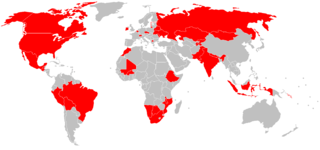Related Research Articles

Modern Standard Hindi, commonly referred to as Hindi, is the standardised variety of the Hindustani language written in Devanagari script. It is the official language of India alongside English and the lingua franca of North India. Hindi is considered a Sanskritised register of the Hindustani language, which itself is based primarily on the Khariboli dialect of Delhi and neighbouring areas. It is an official language in nine states and three union territories and an additional official language in three other states. Hindi is also one of the 22 scheduled languages of the Republic of India.

Mandarin is a group of Chinese language dialects that are natively spoken across most of northern and southwestern China and Taiwan. The group includes the Beijing dialect, the basis of the phonology of Standard Chinese, the official language of China and Taiwan. Because Mandarin originated in North China and most Mandarin dialects are found in the north, the group is sometimes referred to as Northern Chinese. Many varieties of Mandarin, such as those of the Southwest and the Lower Yangtze, are not mutually intelligible with the standard language. Nevertheless, Mandarin as a group is often placed first in lists of languages by number of native speakers.

Urdu is an Indo-Aryan language spoken chiefly in South Asia. It is the national language and lingua franca of Pakistan, where it is also an official language alongside English. In India, Urdu is an Eighth Schedule language, the status and cultural heritage of which are recognised by the Constitution of India; and it also has an official status in several Indian states. In Nepal, Urdu is a registered regional dialect and in South Africa, it is a protected language in the constitution. It is also spoken as a minority language in Afghanistan and Bangladesh, with no official status.
A lingua franca (; lit. 'Frankish tongue'; for plurals see § Usage notes), also known as a bridge language, common language, trade language, auxiliary language, link language or language of wider communication (LWC), is a language systematically used to make communication possible between groups of people who do not share a native language or dialect, particularly when it is a third language that is distinct from both of the speakers' native languages.

Hindustani is an Indo-Aryan language spoken in North India and Pakistan, and functioning as the lingua franca of the region. It is also spoken by the Deccani people. Hindustani is a pluricentric language with two standard registers, known as Hindi and Urdu which serve as official languages of India and Pakistan, respectively. Thus, it is also called Hindi–Urdu. Colloquial registers of the language fall on a spectrum between these standards. In modern times, a third variety of Hindustani with significant English influences has also appeared which is sometimes called Hinglish or Urdish.

In linguistics, romanization is the conversion of text from a different writing system to the Roman (Latin) script, or a system for doing so. Methods of romanization include transliteration, for representing written text, and transcription, for representing the spoken word, and combinations of both. Transcription methods can be subdivided into phonemic transcription, which records the phonemes or units of semantic meaning in speech, and more strict phonetic transcription, which records speech sounds with precision.
An official language is a language having certain rights to be used in defined situations. These rights can be created in written form or by historic usage.
Indian English is a group of English dialects spoken in the Republic of India and among the Indian diaspora. English is used by the Government of India for communication, and is enshrined in the Constitution of India. English is also an official language in seven states and seven union territories of India, and the additional official language in seven other states and one union territory. Furthermore, English is the sole official language of the Judiciary of India, unless the state governor or legislature mandates the use of a regional language, or if the President of India has given approval for the use of regional languages in courts.
A pluricentric language or polycentric language is a language with several codified standard forms, often corresponding to different countries. Many examples of such languages can be found worldwide among the most-spoken languages, including but not limited to Chinese in the People's Republic of China, Taiwan and Singapore; English in the United States, United Kingdom, Canada, Australia, New Zealand, Ireland, South Africa, India, and elsewhere; and French in France, Canada, and elsewhere. The converse case is a monocentric language, which has only one formally standardized version. Examples include Japanese and Russian. In some cases, the different standards of a pluricentric language may be elaborated to appear as separate languages, e.g. Malaysian and Indonesian, Hindi and Urdu, while Serbo-Croatian is in an earlier stage of that process.
A language school is a school where one studies a foreign language. Classes at a language school are usually geared towards, for example, communicative competence in a foreign language. Language learning in such schools typically supplements formal education or existing knowledge of a foreign language.
A national language is a language that has some connection—de facto or de jure—with a nation. The term is applied quite differently in various contexts. One or more languages spoken as first languages in the territory of a country may be referred to informally or designated in legislation as national languages of the country. National languages are mentioned in over 150 world constitutions.

The languages of Singapore are English, Chinese, Malay and Tamil, with the lingua franca between Singaporeans being English, the de facto main language. Singaporeans often speak Singlish among themselves, an English creole arising from centuries of contact between Singapore's internationalised society and its legacy of being a British colony. Linguists formally define it as Singapore Colloquial English. A multitude of other languages are also used in Singapore. They consist of several varieties of languages under the families of the Austronesian, Dravidian, Indo-European and Sino-Tibetan languages. The Constitution of Singapore states that the national language of Singapore is Malay. This plays a symbolic role, as Malays are constitutionally recognised as the indigenous peoples of Singapore, and it is the government's duty to protect their language and heritage.

Fiji has three official languages under the 1997 constitution : English, Fijian and Fiji Hindi. The Fijian language is spoken as the first language by most indigenous Fijians who make up around 54% of the population.

Uttar Pradesh is a multilingual state with 3 predominant languages and 26 other languages spoken in the state. The languages of Uttar Pradesh primarily belong to two zones in the Indo-Aryan languages, Central and East.
The official languages of the United Nations are the six languages used in United Nations (UN) meetings and in which the UN writes all its official documents.
Practices in language education vary significantly by region. Firstly, the languages being learned differ; in the United States, Spanish is the most popular language to be learned, whereas the most popular languages to be learned in Australia are German, French, Italian and Mandarin Chinese. Also, teaching methods tend to differ by region. Language immersion is popular in some European countries, and not used very much in the United States.
Mandarin Chinese is the primary formal Chinese language taught academically to students in Chinese Filipino private schools and additionally across other private and public schools, universities, and institutions in the Philippines, especially as the formal written Chinese language.

Many countries, through the use of censuses, enumerate their populations by languages and by their level of competence in using those languages.
References
- ↑ Hindi (2005). Keith Brown (ed.). Encyclopedia of Language and Linguistics (2 ed.). Elsevier. ISBN 0-08-044299-4.
- 1 2 "How does Hindi USA Teach?". Archived from the original on 2017-05-27. Retrieved 2015-07-22.
- ↑ "US wants young, full-time Hindi teachers for their schools". Archived from the original on August 4, 2014.
- ↑ "हमारा लक्ष्य (Our Mission)".
- ↑ "General Curricula and Textbook Guidelines" (PDF).
- ↑ "Hari Vidya Bhavan: Core Curriculum".
- ↑ "Mukul Hindi School".